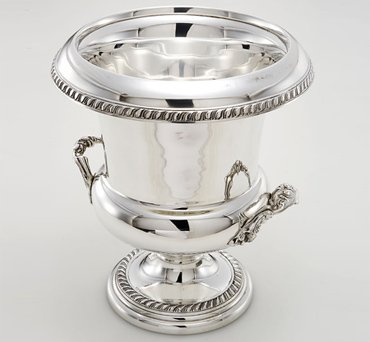|
 |
SILVERWARE
Silver is a chemical element with the symbol Ag (Latin: argentum). A soft white lustrous transition metal, it has the highest electrical and thermal conductivity of any metal and occurs in minerals and in free form. This metal is used in coins, jewellery, tableware, photography, and in mirrors.
Silver is a very ductile and malleable (slightly harder than gold) univalent coinage metal with a brilliant white metallic lustre that can take a high degree of polish. It has the highest electrical conductivity of all metals, even higher than copper, but its greater cost and tarnishability has prevented it from being widely used in place of copper for electrical purposes.
Silver is found in native form, combined with sulphur, arsenic, antimony, or chlorine and in various ores such as argentite (Ag2S) and horn silver (AgCl). The principal sources of silver are copper, copper-nickel, gold, lead and lead-zinc ores obtained from Canada, Cobalt, Ontario, Mexico (historically Batopilas), Peru, Australia and the United States.
The principal use of silver is as a precious metal. Its salts, especially silver nitrate and silver halides, are also widely used in photography (which is the largest single end use of silver). Some other uses for silver are as follows:
• Electrical and electronic products, which need silver's superior conductivity, even when tarnished. For example, printed circuits are made using silver paints, and computer keyboards use silver electrical contacts. Silver (silver cadmium oxide) is also used in high voltage contacts because it can minimize any arcing.
• Mirrors which need superior reflectivity for visible light are made with silver as the reflecting material in a process called silvering. Common mirrors are backed with aluminium.
• Many high end musical instruments are made with silver, which benefit from a higher tone quality.
• Silver has been coined to produce money since 700 BC by the Lydians, in the form of electrum. Later, silver was refined and coined in its pure form. The words for "silver" and "money" are the same in at least 14 languages.
• The metal is chosen for its beauty in the manufacture of jewelry and silverware, which are traditionally made from the silver alloy known as Sterling silver, which is 92.5% silver and usually alloyed with copper. The name of United Kingdom monetary unit 'Pound' originally had the value of one troy pound of sterling silver.
|
|
SILVERWARE ANTIQUE ART
Silver has been used for thousands of years for ornaments and utensils, for trade, and as the basis for many monetary systems. Its value as a precious metal was long considered second only to gold. In Ancient Egypt and Medieval Europe, it was often more valuable than gold.
Judas Iscariot is infamous for having, according to the New Testament, taken a bribe of thirty pieces of silver from religious leaders in Jerusalem to turn Jesus Christ over to the Romans.
Associated with the moon, as well as with the sea and various lunar goddesses, the metal was referred to by alchemists by the name luna. One of the alchemical symbols for silver is a crescent moon with the open part on the left.
TITLE AND HALLMARKS
The Law does not let the products regarded or sold as silver if they are made of alloy inferior to 800 thousandth parts of pure silver. (Low 30.1.68. n.46)
Legal Titles are:
800 - 800 parts of pure silver 200 parts of cooper
835 - 835 parts of pure silver 165 parts of cooper
925 - 925 parts of pure silver 75 parts of cooper
Hallmarks identification
Silver can’t be produced or/and sold without a special licence granted by Italian Government which imposes to put identification hallmark of the manufacturer on each product which include the number of the company and district initials.
|
|
|
|
| |
|